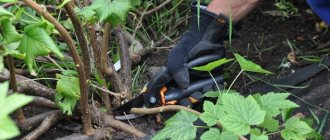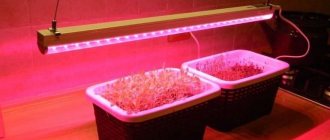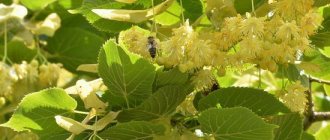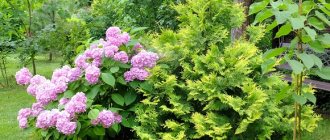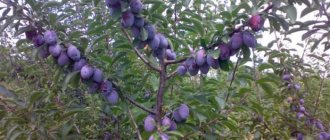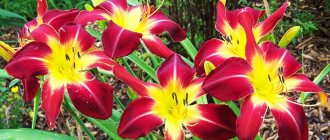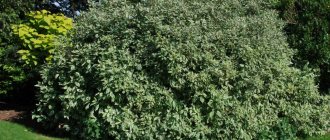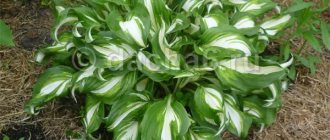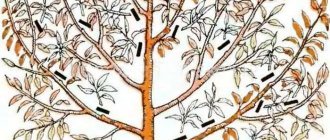Propagation of weigela by cuttings, rooting methods
When pruning the bush, you can save some of the shoots in order to propagate by cuttings. The procedure is planned for early summer or late autumn:
- At the end of May, shoots containing areas of last year's wood are cut off. Their length should be 10 cm.
- It is not forbidden to select blanks from green shoots of the current year cut in the middle or at the end of June. The length of the workpiece should be 15-25 cm, thickness - 0.5 cm. 80% of them take root. It is better to select cuttings when the beginning of lignification is noticeable. The branches should bend well, but not break.
- Weigela can be propagated from last year's woody shoots with 3-5 pairs of buds. They are cut in late autumn and stored in a cool place until spring. Before planting, the shoots are cut below the lower bud and 1-2 cm above the upper bud.
Growing a new seedling from a cutting is an exciting, but painstaking undertaking. The cut shoot is planted either directly in the ground or in a pot. If planting is carried out in open ground, then the length of the cutting must be at least 25 cm. First, all the lower leaves on the cutting are removed, and the upper ones are cut in half to reduce moisture evaporation. The cut is treated with a growth stimulator (Kornevin). The cuttings are placed in the ground at an angle; 2-3 pairs of buds should remain on the surface. Simultaneously with the rooting of mock orange, you can organize the propagation of honeysuckle by cuttings in order to get the first harvest of vitamin-rich berries in 2 years.
Video about molding.
If planting is carried out in a container, then a substrate made up of equal parts of sand and nutrient soil is suitable. You can add a layer of sand 2-3 cm thick on top. The recommended placement pattern is 4*10 cm, depth is 0.5 cm.
Further hoopoe involves watering, loosening the soil, and removing weeds. You can create a greenhouse by covering the plant with a plastic bottle. Rooting occurs in almost all cases after 15-30 days. When new shoots appear, the top must be pinched so that the plant actively branches.
Propagation by green cuttings in summer is easier than growing bushes from woody shoots. It is recommended to trim branches in cloudy weather, since the evaporation of moisture from the stem is lower at this moment. Immediately after cutting, the shoot is immersed in water. For home maintenance, a deep container and a substrate of peat and sand are prepared. The cuttings are buried 0.5-1 cm and covered with a greenhouse. Ventilation is carried out daily for several hours, removing the shelter, and also maintaining the necessary soil moisture. Rooting will occur after 2 weeks.
Rooted cuttings can be immediately transplanted into the ground. Transplantation is carried out in the spring after warming or in early autumn so that the seedling has time to adapt. For the winter, young plantings are carefully covered or dug up for indoor storage. Many varieties of weigela cannot tolerate cold winters even in adulthood, and very young shrubs require special protection. The optimal age for moving a seedling from a pot to a plot is 3-3.5 years.
Growing weigela will not seem difficult even for beginners, thanks to the amazing ability of the bush to grow green mass, regardless of how much pruning has been done. Care and propagation are also not difficult, since green shoots quickly take root.
Types and varieties
For gardeners in our latitudes, more or less winter-hardy weigela species and varieties are of greatest value. These include:
Early weigela, or pleasant weigela (Weigela praecox)
It grows naturally in the Far East. The early weigela bush reaches two meters in height, the leaves are pubescent, and the crown is spherical. The flowers, bright pink on the outside, are collected in inflorescences of 2-3 pieces on the side shoots of the current year. Sometimes the throat of the flowers is yellowish-white; in the buds the flowers have a purple tint. This species blooms from the end of May for 10-30 days. Of interest is Weigela variegata - a variegated variety of Weigela early, the green leaves of which are covered with yellow spots, becoming creamy in summer.
Weigela florida (Weigela florida)
A shrub up to three meters high, the shoots have two rows of hairs. The leaves are on short petioles, serrate, pubescent on top only along the central vein, and pubescent on all veins below. Inflorescences of 3-4 bright pink flowers open at the end of May and bloom for up to three weeks. The most popular forms:
- purple weigela, or red weigela (Weigela Purpurea) - a bush with a dense crown, reaching a height of one and a half meters, the leaves are red-brown, the flowers are deep pink with a yellow throat, blooms in June-July. The variety Nana Purpurea is an almost exact, but smaller copy of weigela purpurea;
- Alba is a dwarf form with white flowers that turn pink as they fade;
- Variegata is an elegant and most frost-resistant form with small leaves, bright pink flowers collected in racemes;
- pink weigela (Weigela florida Bunge) - a form with flowers of pink-carmine color on the outside and pale pink, almost white inside;
- weigela Victoria (Weigela florida Victoria) - a meter-long bush with red-brown foliage, flowers of a crimson hue.
Weigela hybrida
It has a spreading crown and blooms profusely. It reaches a height of one and a half meters. Fragrant tubular-funnel-shaped flowers, solitary or collected in loose inflorescences, bloom in white, pink, purple, lilac and red-violet depending on the variety. The most popular varieties are:
- Weigela Bristol Ruby is a variety bred in the USA in 1941. The height of the bush is from 2.5 to 3 m, the crown diameter is up to 3.5 m. The leaves are bright green. The flowers are pink with a ruby red edge, sometimes with an orange center. Weigela Bristol Ruby grows very quickly and blooms at the end of June;
- weigela Red Prince is a compact bush, also of American selection, one and a half meters high, the crown is spreading, the branches are drooping, the deep red flowers look contrasting against the background of bright green foliage.
Weigela middendorffiana
Bush 1-1.5 m high, ascending shoots, large flowers (3-4 cm), yellow with orange spots in the throat, solitary or collected in few-flowered inflorescences from 2 to 6 pieces each. Blooms twice per season.
In addition to these popular species, their varieties and varieties, weigela profusely flowering, pleasant weigela, early weigela, Japanese weigela, garden weigela, Maximovich weigela and Korean weigela are also grown in cultivation.
Features of caring for weigela in autumn
Pyracantha planting and care, propagation features
Weigel, although not a very easy to care for perennial plant, can often overwinter in the conditions of the Moscow region even without shelter. Preparing ornamental shrubs for winter comes down to simple activities.
Watering mode
Weigela does not tolerate stagnant moisture and does not grow in flooded areas without drainage. As a rule, in rainy autumn conditions the plant does not need watering. Only when the soil is excessively dry should the shrub be watered with settled warm water. Watering is stopped in the second half of September.
Feeding weigela in autumn
In the fall, the third feeding of weigela is carried out. Simultaneously with digging, potassium fertilizers are applied (Kemira-autumn), and it is also practiced to enrich the soil with ash in the amount of 200 grams per square meter of land. An alternative option for autumn feeding of the area under weigela is this: up to 4 kg of humus or compost, 50 grams of superphosphate and 30 grams of potassium sulfate per square meter of area.
Purpose and features of autumn weigela pruning
Shrub trimming is usually done in the spring. Formative pruning of adult bushes should be carried out in the summer before the second flowering of weigela. It takes place on the shoots of the current year. Therefore, they must have time to grow before flowering begins.
Bushes from three to four years of age need rejuvenation. It is done after the second flowering. Adult branches are removed, and young branches are cut by a third. Sometimes every few years all shoots are cut off. The pruning areas are treated with garden varnish. After this procedure, the shrub tolerates wintering better and recovers in the spring.
Weigela pruning is usually done in the spring.
How to prune in spring, summer, after flowering
Sunny flower Heliopsis perennial planting and care, photos, watering and pruning the bush, methods of propagation and other nuances of growing the plant
There are 3 types of pruning:
Planned sanitary pruning is carried out in autumn or spring on young bushes. All frozen, damaged branches are removed with pruning shears. Is it possible to prune young shoots? Yes, if they thicken the bush too much and shade it. To carry out sanitary spring pruning, you need to inspect the branches, find those whose tips are slightly blackened. This occurs due to freezing during the winter.
Rules for sanitary spring and autumn weigel haircuts:
- You need to cut the stems from the moment the buds swell.
- The shoot is cut off so that 1 cm remains from the outermost living bud.
- Branches with stains and mechanical damage must be removed.
- Sanitary pruning can be done in the fall, but before the onset of cold weather, otherwise the plant will not have time to adapt and will suffer greatly in winter. To make the branches stronger, they are pruned 3 weeks before the onset of the first frost.
Adult weigels require shaping to achieve the desired shape. In the first years of life, it is enough to take care of the successful growth of the seedling, and then begin molding pruning, transforming the crown into a ball, pyramid or cube.
Cut off the shoots by 1/3. The more young stems that grow, the more abundant the re-blooming will be. After cutting, the bush is fertilized with complex preparations, potassium sulfate, or the tree trunk circle is mulched with humus. It is not forbidden to use liquid mullein (proportion 1:10) before a new wave of flowering.
To rejuvenate the plant, you will have to cut stems older than 3 years onto the stump. They form buds only at the tops, so they need to be replaced periodically in order to enjoy the abundant flowering of the bush every year. The cut areas must be treated with garden varnish.
Weigela pests and diseases
Weigela is a fairly robust bush that does not have any particular problems with diseases and insects. Although some pests are dangerous to her too.
If a young weigela seedling weakens, dries out despite watering, and drops its leaves, it is worth digging it up and inspecting the roots for the presence of beetleworm.
Most often, the bush is affected by aphids, leaf-eating caterpillars, thrips and, occasionally, spider mites. There is no need to panic: if there are still few insects, you can get by with folk remedies, but if they have already taken over the entire plant, you will have to use industrial chemicals.
- All garden pests - photos, names, descriptions and control measures
We have collected for you dossiers on 60 or more garden “villains”.
If we talk about diseases, weigela suffers from rust, spotting and gray rot. In early spring (before buds open) and late autumn, it is worth prophylactically treating the bush with 1% Bordeaux mixture.
Varieties of weigela video
Common privet planting, methods of propagation and simple rules of care
Weigel Middendorf
The tall shrub blooms in May-June with large cream flowers with orange specks. At the beginning of autumn, re-blooming occurs, although not as lush as in spring. In nature, it grows in cedar and mixed forests in Primorye, Sakhalin, China and Japan, alone or forming dense thickets. Loves sunny places near bodies of water. The leaves are oblong, ovoid in shape. Small winged seeds are placed in an elongated box.
Veigel Maksimovich
This is a shrub one and a half meters high with eight-centimeter long, fleecy leaves with short petioles. The flowers are bell-shaped, pale yellow, up to four centimeters in size, arranged in pairs on short branches. Flowering occurs in late spring and early summer. It is meager, few fruits appear. They ripen in mid-autumn; the seeds with wings are in boxes. In autumn, the color of the leaves changes to yellow-red. Weigela does not shed its leaves in winter.
Weigel Middendorf
profusely blooming
It comes from the mountainous regions of Japan and grows to a height of three meters. The leaves are oblong, large, pubescent below and on the petioles. The three-centimeter flowers are at first dark red, then lighten, they are also pubescent. The shrub grows quickly and needs moisture and fertile soil. Thanks to the height of the curved and beautifully flowering branches, it looks impressive next to trees and on the borders of paths.
Pleasant
Low bushes with bright green leaves live in cedar forests, in the highlands of Primorye, on Sakhalin. In mid-September the color changes, and in October they fall off. Thanks to the graceful colors of the funnel-shaped flowers - purple on the outside and soft pink on the inside - this species is considered the most attractive among all. The first flowering occurs in May-June, and the second at the end of summer. Looks great on lawns and in combination with coniferous and deciduous shrubs.
Weigela profusely blooming
Early
It grows in China, in the north of Korea, in the south of the Ussuri forests. A light-loving, spreading shrub with dense foliage and gray or reddish bark grows up to two meters in height. The seven-centimeter bright green leaves turn brown-yellow or ocher in autumn. The bright pink flowers bloom profusely and have an original shape. The plant easily survives replanting, is not demanding on the composition of the soil, looks impressive in hedges, and does not require pruning. But in cold winters it needs to be covered.
Sadovaya
A low shrub native to Japanese forests. The leaves are large and sit on short stalks. The flowers are tricolor, numerous, tubular-bell-shaped. The first wave of flowering occurs at the end of May, and the second in July. The color of the leaves changes in October, but the plant does not always have time to shed them before the cold weather. The frost and drought resistance of the plant is more pronounced in mature specimens. Loves bright sun, grows alone or in small groups. There are varieties with white flowers.
Weigela early
Blooming
The plant's homeland is Primorye, Japan and northern China. This is a three-meter shrub with red-brown or gray shoots. It can grow in the sun and in the shade, but in the latter case the leaves lose their decorative color. In the Moscow region, one cannot do without shelter for the winter. When frozen, it easily recovers and even blooms in the first season, albeit belatedly. Needs moist, fertile soils with a slightly acidic reaction. Garden forms with brown-red leaves and dark pink, yellow in the middle flowers have been developed. There are also varieties with small white flowers that later turn pink. White specks are clearly visible on their leaves.
Botanical description
The weigela flower is moisture-loving and relatively shade-tolerant. This erect shrub does not form stolons, the leaf arrangement on its shoots is opposite, the leaves are petiolate, without stipules, serrate or serrated. The flowers, funnel-shaped or bell-shaped, up to 5 cm long, solitary or collected in loose inflorescences, come in pink, cream, yellow, carmine red and other colors, which can change during the flowering process from a lighter shade of color to a more saturated one. After flowering, the weigela bush produces fruits - bivalve capsules with small seeds.
- Irises in the garden
Weigela landing
Choosing a location. First of all, when choosing a place to plant weigela, you must be guided by the characteristics of the species or variety of this plant you have chosen. The fact is that, in addition to other significant differences between them, there are two main ones - there are beautifully flowering species, and there are variegated ones, in which (as follows from the definition) the main decorative effect lies in the beauty of the foliage. Of course, all types of weigela prefer well-lit areas, but while flowering ones can thrive in partial shade, variegated ones reveal all their beauty only in the sun. This shrub is considered quite suitable for creating a hedge, but keep in mind that if you are a supporter of neatly trimmed bushes and strict geometry, then it will not suit you for use in this capacity. This will be the so-called uncut (unedged) hedge. In general, weigela looks equally great both as a single plant and in a group with other plants. It goes very well with low-growing spirea, forsythia, and coniferous trees. But no matter how much you want to place it in one place or another, be sure to take into account the fact that this place must be well protected from cold winter winds, which can not only freeze the plant, but also break off its fragile branches. Therefore, if the climate in your area is not entirely gentle, then planting weigela in a group with other more resistant plants will be more preferable. Not only will they cover it from drafts, but such a group will also hold snow better. And, of course, keep in mind that you are choosing a place to plant weigela for a long time. It is able to grow and maintain its beauty for up to 50 years without transplantation, in one place!
Soil requirements. By and large, the composition of the soil is not particularly important for weigela. It can be loam or sandy loam soil, the main thing is that it is sufficiently fertile. It is highly desirable that it also has good moisture and air permeability, since weigela is a moisture-loving plant and reacts very negatively to dry soil.
Preparing for landing. Even if the soil in the place you choose is quite fertile, it won’t hurt to prepare it before planting weigela. This is not difficult to do. First, a planting hole is dug (50x50x50). The excavated soil can be mixed equally with compost and one hundred to one hundred and fifty grams of nitrophoska can be added to the mixture, or you can get humus and mix it with sand and turf soil (in a ratio of 1:2:2), replacing the excavated soil with this mixture. In order to avoid unwanted stagnation of water, a layer of drainage (10-15 cm) must be laid at the bottom of the planting hole. For drainage, you can use medium-fraction gravel mixed with sand.
Landing dates. Considering the rather low frost resistance of weigela, you should refrain from autumn planting; the young plant may simply not have time to adapt and prepare for wintering. It should be planted in early spring, immediately after the snow melts and the soil thaws. Most often this period occurs in April. For planting, it is preferable to use two to three year old seedlings
Be sure to pay attention to this! When purchasing a seedling, be sure to find out its age. A too young, immature seedling has a much lower chance of taking root.
Features of landing. If you are planting not just one weigela bush, but a group of several, then keep in mind that the distance between neighboring plants should be at least three meters, and dig holes with this in mind
Please note that the root collar of the plant is not buried deep during planting. Leave 1.5-2 cm of neck on the surface
As the soil subsides, it will drop to the required depth on its own. Don't ignore mulching. As already noted, overdrying the soil negatively affects the appearance of the plant.
How to propagate weigela?
There are two main methods of propagating weigela: wood cuttings and seeds. Most often the first one is used. Experienced gardeners recommend using for this purpose not already formed woody shoots, grown independently from large green buds.
The choice of propagation method in a particular case depends on the type of plant you choose. For example, Weigela Middendorf is best propagated by cuttings obtained in summer or spring. But flowering Weigela is less picky about the propagation method: plants obtained from cuttings grown in summer or winter, or from seeds, as well as from layering from a bush, take root well and bloom vigorously.
Cotoneaster horizontal. See and read the photo and article about this shrub here. And this article talks about the David's buddleia bush.
Weigela shelter for the winter
It’s worth saying right away that weigela is not highly winter-hardy; on the contrary, the plant is considered to be quite heat-loving, which is why it often freezes in the spring and winter.
Therefore, most flower growers who grow weigela on their plots have come to the conclusion that it can only be achieved by covering it for the winter.
Of course, if you live in the South, you are unlikely to experience difficulties with growing and wintering weigela, but for gardeners in the Middle Zone (Moscow region), Leningrad region and more northern cold regions, this is a real problem, especially if the winters are snowless...
Which varieties of weigela require mandatory shelter, and which ones require mulching?
Variegated varieties have the lowest winter hardiness and weaker immunity.
But large, fast-growing varieties often simply do not have time to prepare for winter (their shoots do not ripen), which is why they freeze out, however, in the next season they, as a rule, recover (after all, it is not for nothing that they are called fast-growing) and delight again us with its flowering.
Best suited for growing in a cool climate, for example, the same central zone (Moscow region), are low-growing or dwarf (up to 1-1.2 meters in height) red-leaved varieties of weigela, which winter well under the snow.
Also, in the conditions of the Moscow region, weigela variety Florida Victoria overwinters well without shelter.
Sometimes you can find a recommendation to plant Red Prince (“Red Prince”).
Variegated and fast-growing varieties of weigela require mandatory shelter for the winter, but red-leaved varieties need not be specifically covered, except by mulching and throwing snow on top.
How to mulch and how to cover weigela for the winter
Weigels can be mulched with humus, compost and leaves of ornamental trees (but not fruit trees).
Just cover the bushes with mulch on all sides and that’s it.
But covering weigels is much more difficult, because they do not have very flexible branches to make it convenient to bend them (they are fragile and can easily break).
Therefore, you need to make a frame shelter or somehow slightly tilt it (for example, by placing something) and cover it with non-woven material (spunbond, lutrasil).
Thus, now you know that for annual abundant flowering of weigela, you need to regularly trim it and cover it for the winter, and also improve winter hardiness by applying phosphorus-potassium fertilizers, or immediately choose a fairly winter-hardy variety.
Video: care for weigela and its wintering
Weigela is a flowering ornamental shrub that is grown in composition as a single plant or to form picturesque hedges. Gardeners achieve maximum decorativeness through properly organized pruning of weigela in spring and autumn. The procedure is mandatory if the gardener wants to enjoy repeated, lush flowering.
What is important to know about autumn planting of weigela
Ornamental shrubs that are planted in the spring, during the period from the soil warming up to the swelling of the buds, take root best. Seedlings planted in autumn most often die in the first winter, which is due to the botanical characteristics of the heat-loving ornamental plant. For planting you need to choose a place on a hill
, protected from the cold northern wind and strong drafts that cause flowers and buds to fall off.
The south side of the house with good sunlight is optimal for planting and growing. To obtain abundant and long-lasting flowering, the soil on the site must be loose and rich in humus. Preference should be given to sandy or loamy soils that have a slightly alkaline or neutral reaction.
It is important to remember that only plants at least three to four years old are suitable for planting.
Before planting seedlings, high-quality drainage must be laid in pre-prepared planting holes. Optimal for planting are holes with dimensions of 50x50 cm and a depth of approximately 35-40 cm in depth. Brick or gravel 15 cm high is laid at the bottom. To fill the holes, garden soil is used with the addition of 40 g of potassium salt and 60 g of superphosphate. The trunk circles of planted plants are mulched with crushed bark or sawdust. An ornamental crop planted in this way quickly takes root and delights with abundant flowering.
About propagation of weigela by cuttings in autumn
- Weigela begins preparing cuttings for propagation at the end of summer. Branches about a centimeter thick, reaching a length of up to two tens of centimeters, are suitable for cuttings. After pruning, the lower leaves are removed and kept in a growth stimulator.
- Until spring, the cuttings are placed in the ground. There is no need to dig holes in the garden bed for them. It is better to choose a shaded place for planting cuttings. Soil preparation begins with the addition of humus. If the soil is acidic, then add lime to the garden bed.
- The cuttings are placed to a depth of 10 cm, leaving a distance of up to a quarter of a meter between neighboring plants, the soil is compacted and watered.
- After a year, the cuttings are replanted half as often. And after a couple of years, they are buried at an angle, completely covering the roots and part of the crown with soil, so that wintering goes well. Before this, prepare a planting hole with a volume of 50 by 50 cm, fill it with the same amount of humus and sand and half the volume of turf soil. It is also possible to fertilize the soil with two buckets of compost and 100 grams of nitrophoska.
Bushes are planted at a distance of two meters from each other if they are tall varieties of shrubs and half as often if they are short. The root collar of weigela should be at soil level when planting.
After the soil shrinks as a result of watering, it will lower by a couple of centimeters, which is necessary for the successful wintering of the shrub.
Weigela is a flowering perennial shrub valued for its spring and summer ornamental flowers. Their aroma is reminiscent of honeysuckle. Often planted as hedges, these plants do not require much care, but they still require care. Preparing your weigela for winter will help it survive the cold with minimal damage.
Reproduction
Of course, the easiest and most reliable way to enjoy weigela flowering in your garden is to buy a grown seedling. 3.5 year old seedlings that are planted in sunny and half-shaded areas and receive regular moderate watering adapt best to new conditions and take root. But in the tradition of our summer residents, it is still not buying a ready-made plant, but growing it independently from seeds or cuttings. Remember with what pride the neighbors at their summer cottages showed each other their gardening achievements and how generously they shared advice, seeds, seedlings and cuttings.
Weigela propagates in two ways: by seeds and cuttings. Propagation by seeds is not a very labor-intensive process, which, however, requires two to three years of patience from the gardener. Experienced gardeners do not advise sowing seeds in boxes with sand and growing sprouts. It is much easier to leave the seeds of a faded shrub that have awakened in the fall in the ground, and in the spring to leave the strongest shoots and grow them for two years, and then transplant them to a permanent place. This is a simple method, but not the most reliable. Therefore, experienced flower growers prefer propagating weigela, like many other ornamental shrubs, vegetatively, that is, by cuttings.
Spring care
When the cold weather has subsided, you can begin actively caring for the plant.
Spring pruning
Although weigela is a hardy plant, it can suffer from frost damage, especially in areas with harsh winters. Therefore, at the end of winter, the plantings need to be inspected and all damaged (dead) branches should be cut off.
We recommend reading about how to choose pruners for your garden.
Upon visual inspection, you will notice stems on which the buds have not started to grow. These dead branches will be dry and black when cut and should be cut away with pruning shears until light, living wood emerges.
Thanks to this procedure, the plant will recover faster after winter and grow new shoots. If it is not too clear whether a branch is alive or not, you need to scratch its bark with your fingernail. When it turns out that the wood tissue (sapwood) under the bark is greenish-white, the stem is healthy; dry tissue indicates that the branch has died.
Remove dead branches using sharp pruning shears or a pruning knife. Tool blades should be wiped with alcohol before each cut to prevent the spread of disease.
If necessary, you can remove damaged or frozen branches at the end of winter, but in order to preserve flower buds, experts recommend postponing this procedure to spring. If the bush is old and very overgrown, you can rejuvenate it by removing several large branches at the end of winter.
Cut them off near the base of the bush so that light penetrates into the thickets, this will encourage the formation of new shoots. Old, thick branches may need to be removed with a pruning saw, as pruning shears will not cut through such coarse wood.
Video: caring for Viigela

